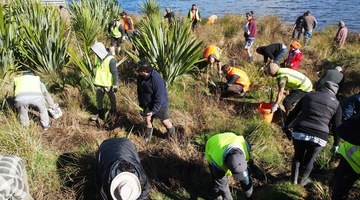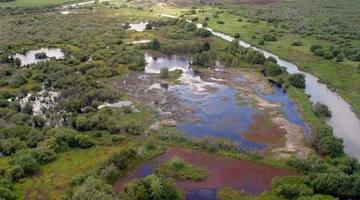Researcher Cheri van Schravendijk-Goodman explains why some plants are considered pest plants within the Waikato River catchment. These plants invade the catchment area and often compete with natives for the same resources.
Transcript
CHERI VAN SCHRAVENDIJK-GOODMAN
The key pest plants within the Waikato River catchment – we’ve got yellow flag iris. They are the ultimate colonising machine. One flowerhead can produce numerous seeds, and the seeds look like little mini air hockey discs. They’re built for flotation, so as soon as that pod breaks and all those seeds scatter, they basically sit on the river and they get transported into any aquatic environment. They are adapted to cope with saltwater as well. It gets really clumpy, natives struggle to come up through it, it can propagate itself from its rhizomes, so its root mass. It doesn’t need seeds to propagate, and they’ve also been recognised as being toxic to stock, so you don’t want your cattle having a browse in these things.
The other invasive plant that is a major concern on the river is alligator weed. You only need a little teeny tiny piece of the plant to break off and move away, and bang, you’ve got a whole new clump of them starting up again. That’s a problem because again it just outcompetes where some of our native plants could be existing, and it’s just highly invasive.
Another one is sweet reedgrass. It looks a bit like an iris or a lily, sits in the water. The problem is when you get them en masse – it’s like walking through a field of paper cuts, it is horrible. It sits right at the top of my list of plants that I hate, and basically because it forms itself on the edges of the river or around areas where our whitebait might be spawning, it makes the habitat unsuitable for our whitebait. Because if our skin is getting cut up by walking through it, our whitebait getting cut up when they’re trying to go in there and lay their eggs, and they lay their eggs in overhanging vegetation
The other two really common ones are trees. So we have the crack willows and the grey willows. Crack willow tends to be along the stem of the river, grey willow tends to invade in wetlands. And then we’ve got the alder or rākau Pākehā – they’re a tree that’s been popping up all over the river as well and was deliberately introduced here for fuelling of the barges when they used to go up into the river.
Acknowledgements:
Cheri van Schravendijk-Goodman
Karyn Okeroa-McCrae
Timi Manukau
Fungus Guy http://creativecommons.org/licenses/by-sa/3.0/deed.en
Museum of Toulouse http://creativecommons.org/licenses/by-sa/3.0/deed.en
The Waikato Tainui College for Research and Development acknowledges the financial support given by the Waikato River Cleanup Trust Fund which is administered by the Waikato River Authority.
The Waikato River Cleanup Trust does not necessarily endorse or support the content of the publication in any way.




